I'll craft detailed sections highlighting unique colonial design elements, ensuring each captures the essence of historical authenticity and architectural precision.Colonial dining rooms represent timeless elegance that blends historical charm with functional design. These spaces showcase traditional American furniture, warm color palettes, and architectural details that create inviting atmospheres for family gatherings and formal entertaining. From handcrafted wooden tables to brass chandeliers, colonial design emphasizes natural materials, quality craftsmanship, and understated sophistication. Whether you're working with an authentic period home or creating colonial character in a modern space, these design ideas will help you achieve the perfect balance of historical authenticity and contemporary comfort.
1. Windsor Chair Colonial Dining Room Setup
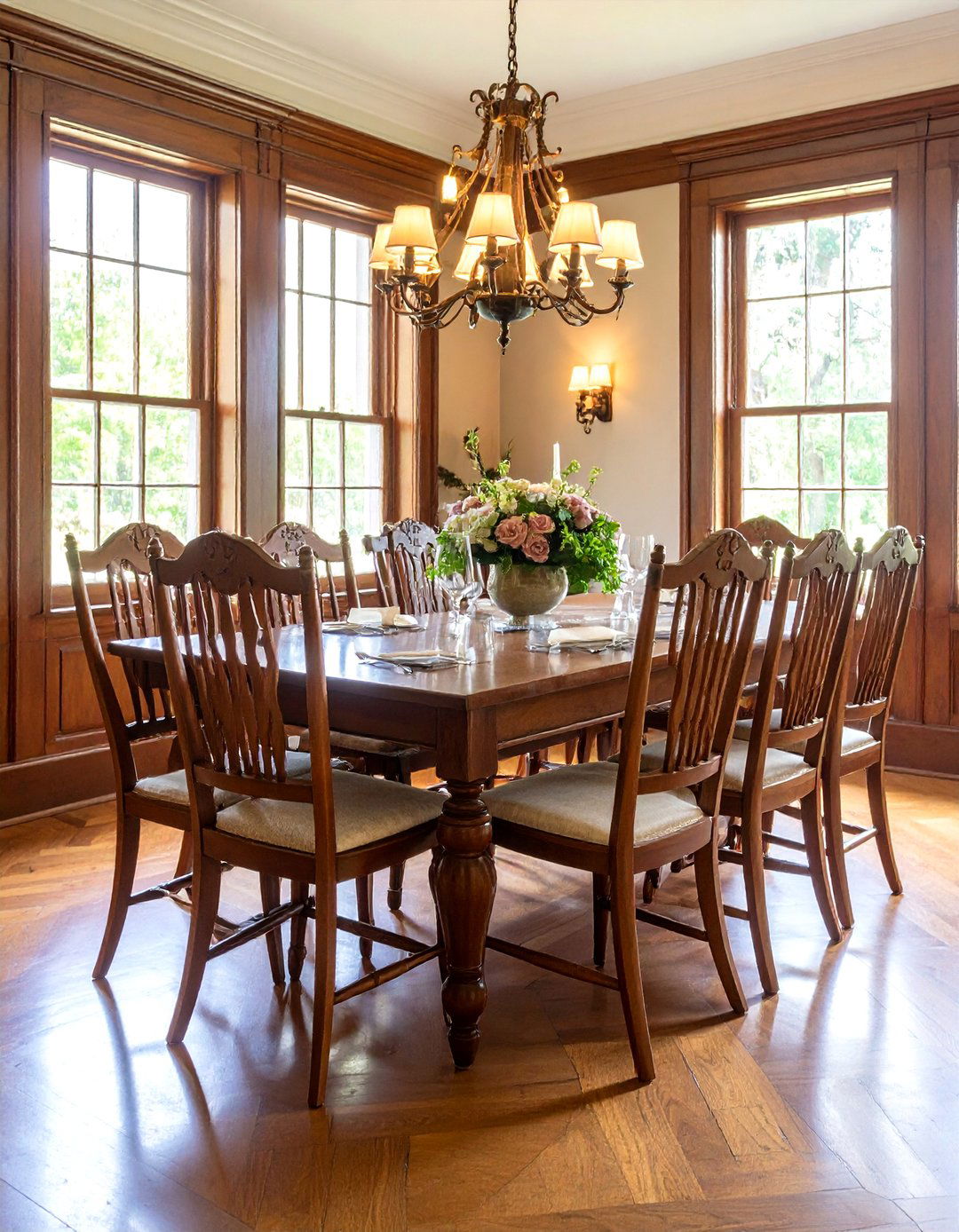
Classic Windsor chairs serve as the cornerstone of an authentic colonial dining room design. These iconic pieces feature distinctive spindle backs, curved bow designs, and solid wooden seats that exemplify traditional American craftsmanship. Arrange four to eight Windsor chairs around a sturdy oak or maple dining table to create an inviting colonial atmosphere. The chairs' clean lines and handcrafted appearance complement both formal and casual dining settings. Choose chairs in matching wood tones or embrace slight variations for added character. Pair with simple table linens in natural fabrics like linen or cotton to maintain the authentic colonial aesthetic while ensuring comfort for modern dining experiences.
2. Wainscoting Colonial Dining Room Design
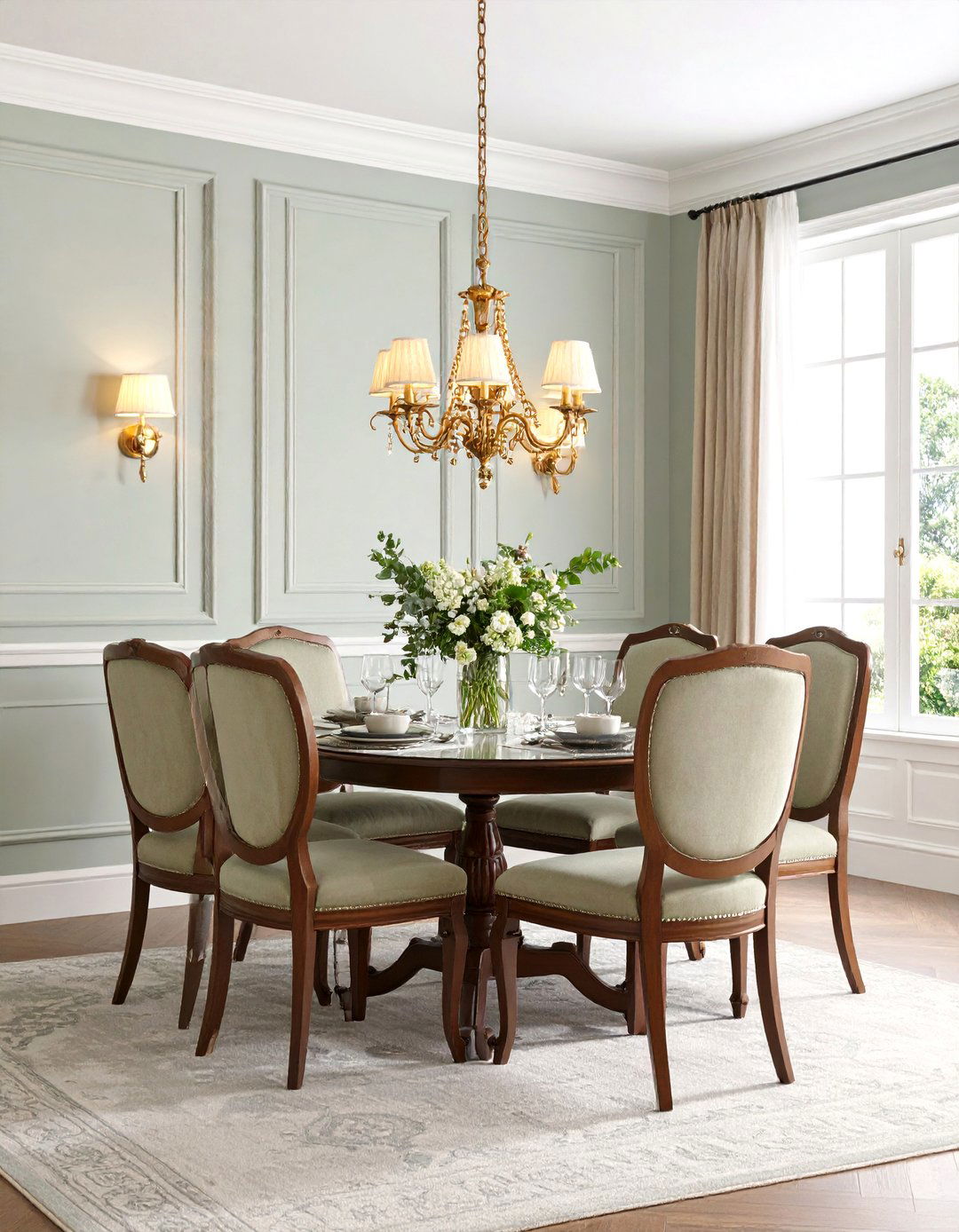
Transform your dining space with traditional raised panel wainscoting that captures the essence of colonial architecture. Install wood paneling extending one-third up the wall height, typically around 36 inches, using classic materials like oak, pine, or painted MDF for budget-friendly options. The raised panels create visual depth and historical authenticity while protecting walls from chair damage. Paint the wainscoting in crisp white or cream to contrast beautifully with sage green, deep blue, or warm gray wall colors above. Complete the look with traditional chair rail molding and baseboard trim. This architectural detail instantly elevates any dining room, creating the sophisticated backdrop that defines colonial interior design.
3. Brass Chandelier Colonial Dining Room Lighting
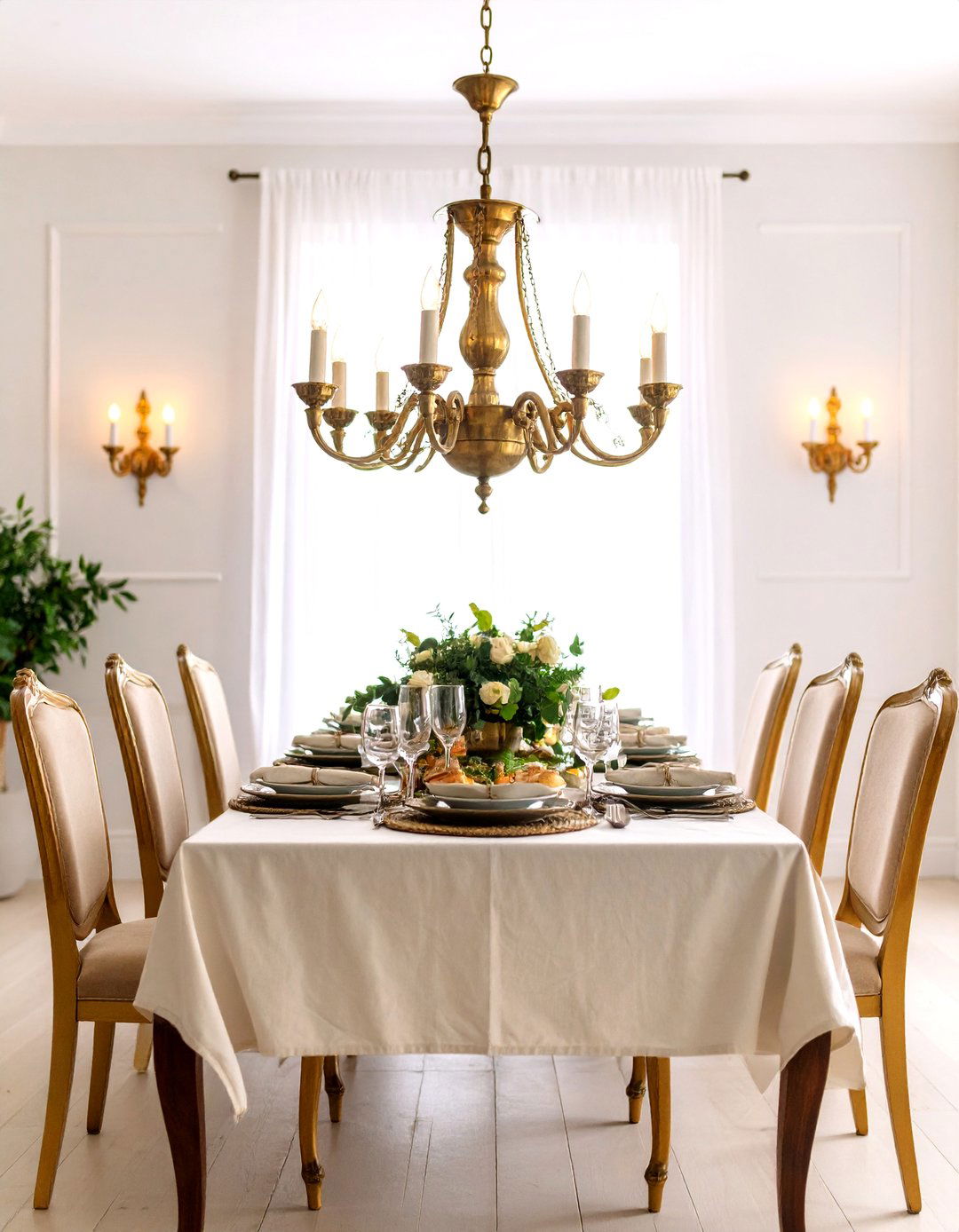
Illuminate your colonial dining room with a stunning brass chandelier that serves as both light source and statement piece. Traditional colonial chandeliers feature warm brass or bronze finishes with multiple candle-style bulbs arranged in tiers or circular patterns. Position the fixture centrally above your dining table, ensuring it hangs 30-36 inches from the table surface for optimal lighting and visual balance. The brass finish develops a beautiful patina over time, adding authentic character to your space. Complement the chandelier with matching brass wall sconces or table lamps to create layered lighting that enhances the warm, welcoming atmosphere essential to colonial dining room design.
4. Farmhouse Table Colonial Dining Room Arrangement

Center your colonial dining room around a substantial farmhouse table crafted from solid hardwood like oak, maple, or cherry. These tables feature thick plank tops supported by sturdy turned or tapered legs, embodying the practical elegance of colonial furniture design. Choose a table that comfortably seats your family with room for guests during special occasions. The natural wood grain should remain visible through clear stains or oil finishes that highlight the material's beauty. Surround the table with a mix of ladder-back chairs and a wooden bench to create flexible seating options. Add a simple table runner in natural linen to protect the surface while maintaining the authentic colonial aesthetic.
5. Wall Sconce Colonial Dining Room Illumination
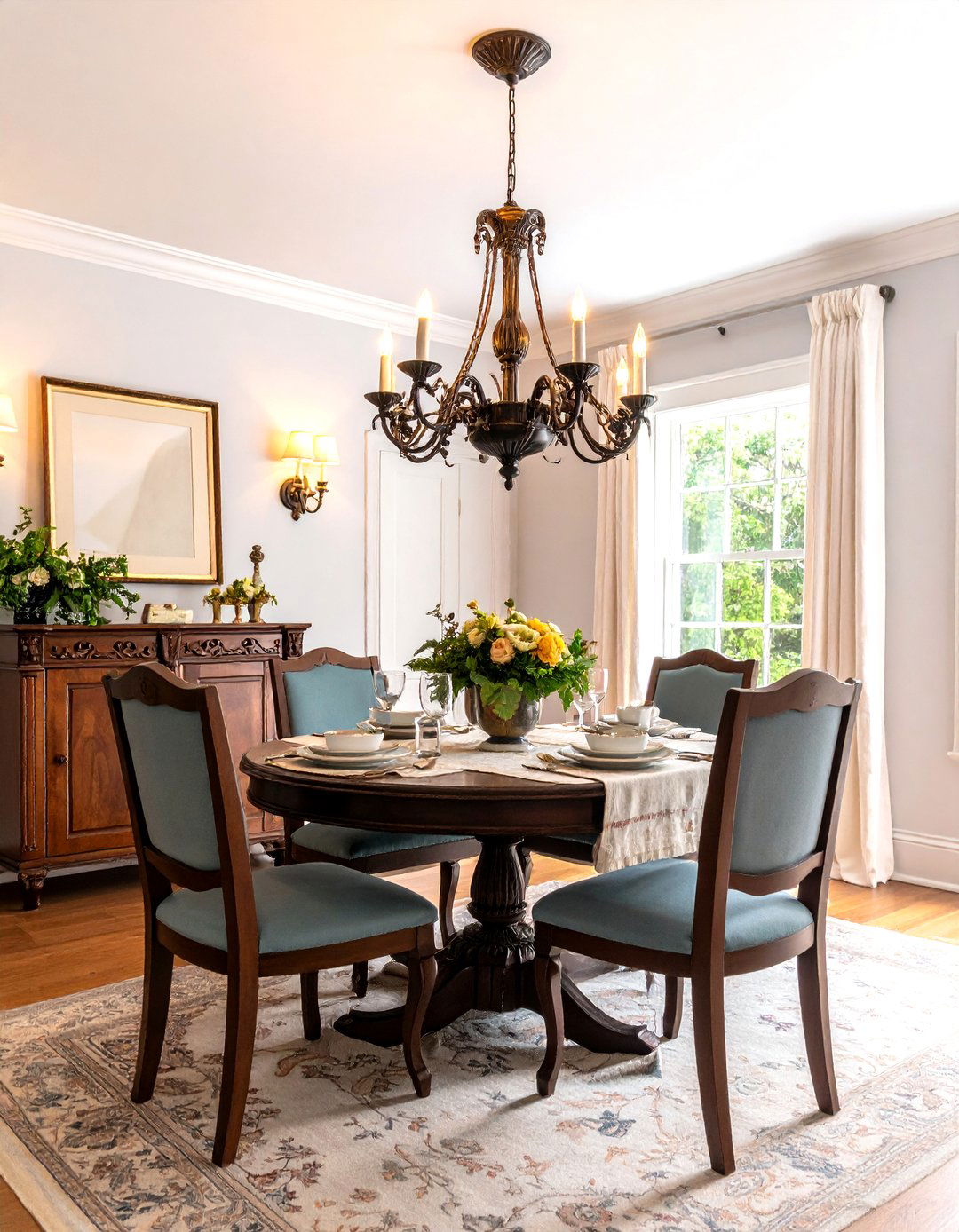
Enhance your colonial dining room's ambiance with carefully placed wall sconces that provide warm, atmospheric lighting. Choose fixtures made from brass, pewter, or wrought iron featuring candle-style bulbs or lantern designs that reflect traditional colonial lighting methods. Install sconces on either side of a hutch, fireplace, or artwork to create balanced illumination throughout the space. The fixtures should complement your main chandelier while providing additional layers of light for intimate dining experiences. Consider sconces with glass hurricane shades or metal reflectors that direct light both upward and downward. This traditional lighting approach creates the cozy, welcoming atmosphere that makes colonial dining rooms perfect for extended family meals and entertaining.
6. Beadboard Colonial Dining Room Wall Treatment
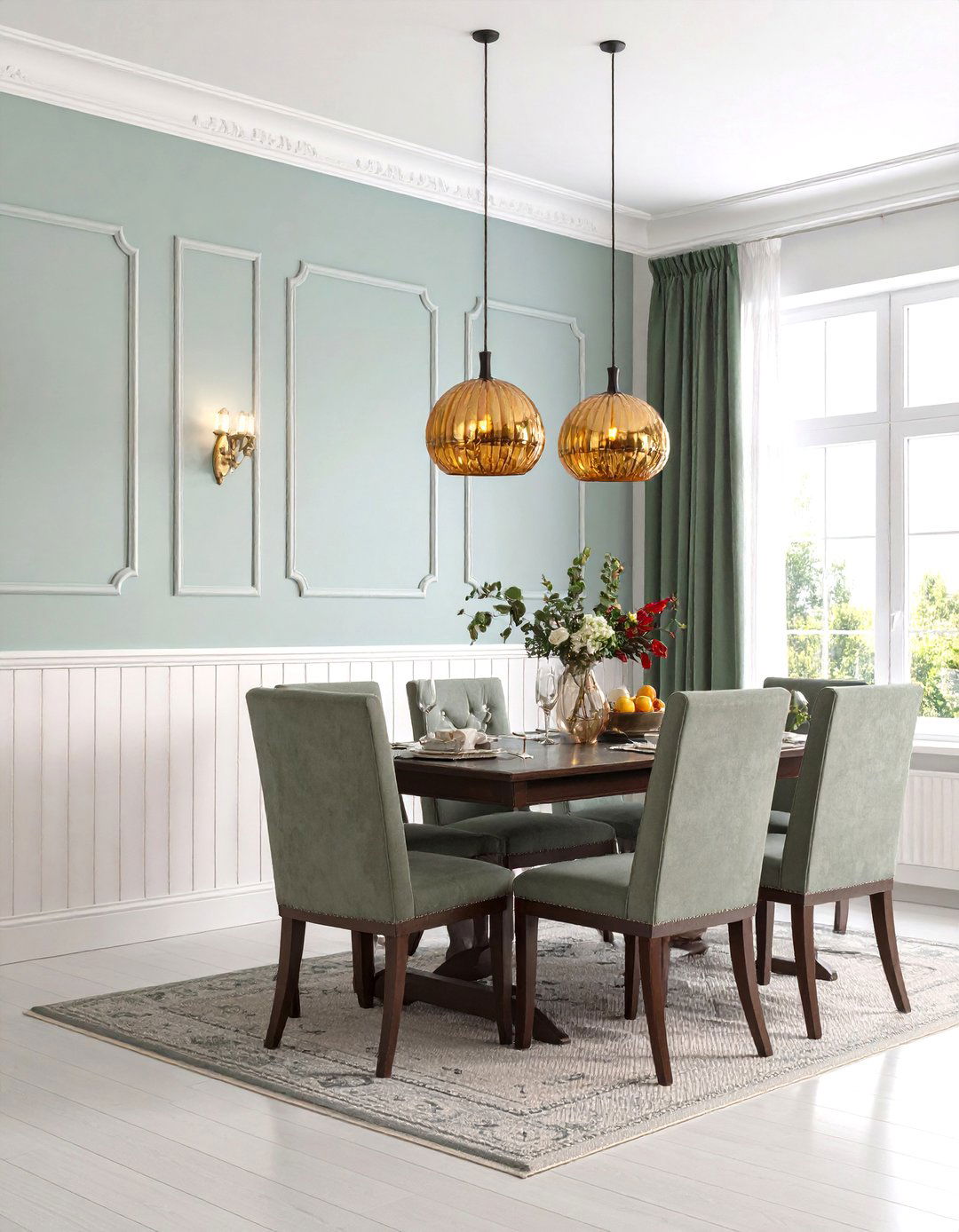
Create authentic colonial character with beadboard paneling that brings New England charm to your dining space. Install tongue-and-groove beadboard panels from floor to chair rail height, typically 32-40 inches, painting them in classic white or soft cream colors. The vertical lines of beadboard add visual height to the room while providing durable wall protection in high-traffic areas. Above the beadboard, paint walls in complementary colonial colors like warm gray, soft blue, or muted green. The combination creates an attractive two-tone effect that captures traditional colonial styling. Add a decorative chair rail to separate the beadboard from the upper wall treatment, completing this timeless architectural detail that defines colonial interior design.
7. Pewter Accent Colonial Dining Room Decor

Incorporate authentic pewter accessories throughout your colonial dining room to capture the metalwork traditions of early America. Display pewter pitchers, serving bowls, candlesticks, and charger plates on open shelving, hutches, or as table centerpieces. The matte gray finish of pewter provides elegant contrast against dark wood furniture and warm wall colors. Arrange pewter pieces alongside other traditional materials like wooden bowls, ceramic crockery, and wrought iron accessories. These metalwork accents reflect the colonial era's emphasis on functional beauty and skilled craftsmanship. Choose reproduction pieces or authentic antiques to create layers of historical interest. The pewter's subtle luster adds sophistication while maintaining the understated elegance characteristic of colonial decorative arts.
8. Corner Cabinet Colonial Dining Room Storage
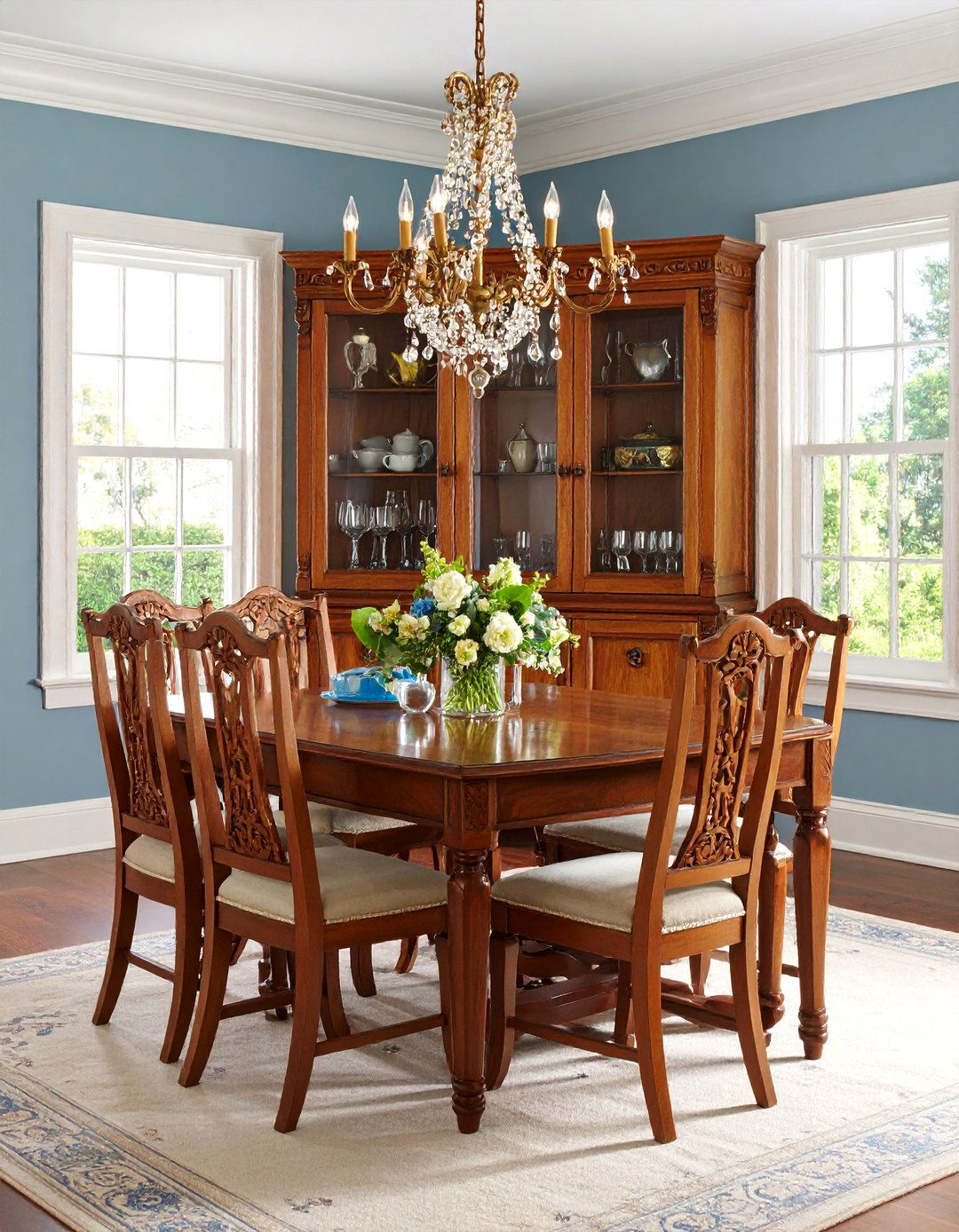
Maximize your colonial dining room's functionality with a traditional corner cabinet that provides both storage and display opportunities. Choose a piece featuring glass-front upper sections for showcasing fine china, pewter, or collectibles, with solid lower doors concealing everyday items. The cabinet should be crafted from solid wood matching your dining table and chairs, typically in oak, cherry, or painted finishes. Position the corner cabinet to fill unused space while creating visual balance in the room. Traditional colonial corner cabinets often feature carved details, raised panels, or decorative hardware that enhance their architectural appeal. This practical furniture piece embodies the colonial principle of combining beauty with functionality while adding vertical interest to your dining space.
9. Fireplace Colonial Dining Room Focal Point

Transform your colonial dining room by centering the design around a traditional fireplace that serves as the room's commanding focal point. Surround the hearth with classic materials like brick, stone, or painted wood paneling that reflects colonial construction methods. Install a substantial wooden mantelpiece displaying pewter candlesticks, ceramic vessels, or seasonal arrangements. The fireplace provides both physical warmth and visual anchor for furniture arrangement, with the dining table positioned to take advantage of the cozy atmosphere. Consider adding built-in seating or bookcases flanking the fireplace to maximize the space's functionality. This architectural feature captures the essence of colonial living, where the hearth served as the heart of family gatherings and community celebrations throughout the seasons.
10. Ladder-Back Chair Colonial Dining Room Seating
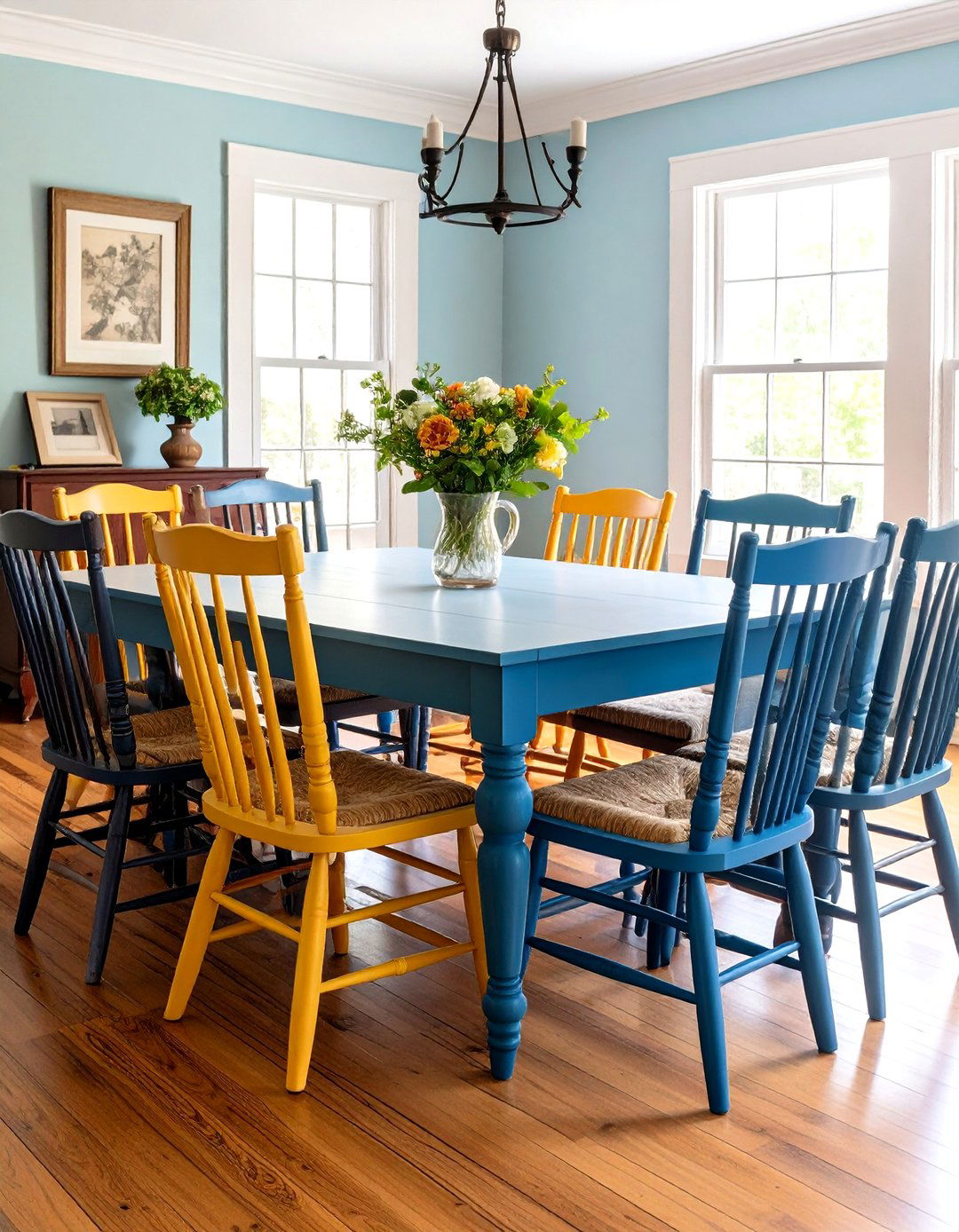
Complete your colonial dining room with authentic ladder-back chairs that showcase traditional American furniture craftsmanship. These chairs feature horizontal slats forming the distinctive ladder pattern across the back, supported by turned or tapered legs and stretchers. Choose chairs with rush seats for ultimate authenticity, or opt for upholstered cushions in natural fabrics for added comfort. The simple, functional design embodies colonial values of practicality and durability while providing comfortable seating for extended meals. Mix ladder-back chairs with other colonial seating styles like Windsor chairs or benches to create visual interest. The handcrafted appearance and clean lines of these chairs complement any colonial table while maintaining the honest, unpretentious character essential to this timeless design style.
11. Hardwood Floor Colonial Dining Room Foundation

Establish your colonial dining room's authentic foundation with wide-plank hardwood flooring that reflects traditional construction methods. Choose floors made from native American woods like oak, maple, cherry, or pine, finished with natural stains that highlight the wood's character. Wide planks, typically 5-8 inches, create the historical accuracy and visual warmth essential to colonial design. The natural variations in wood grain and color add depth and interest beneath your furniture arrangement. Consider hand-scraped or distressed finishes for added authenticity, or refinish existing floors with period-appropriate stains. Complete the flooring with traditional area rugs in muted patterns or braided designs that complement the colonial color palette while defining the dining space and adding comfort underfoot.
12. Built-in Hutch Colonial Dining Room Display
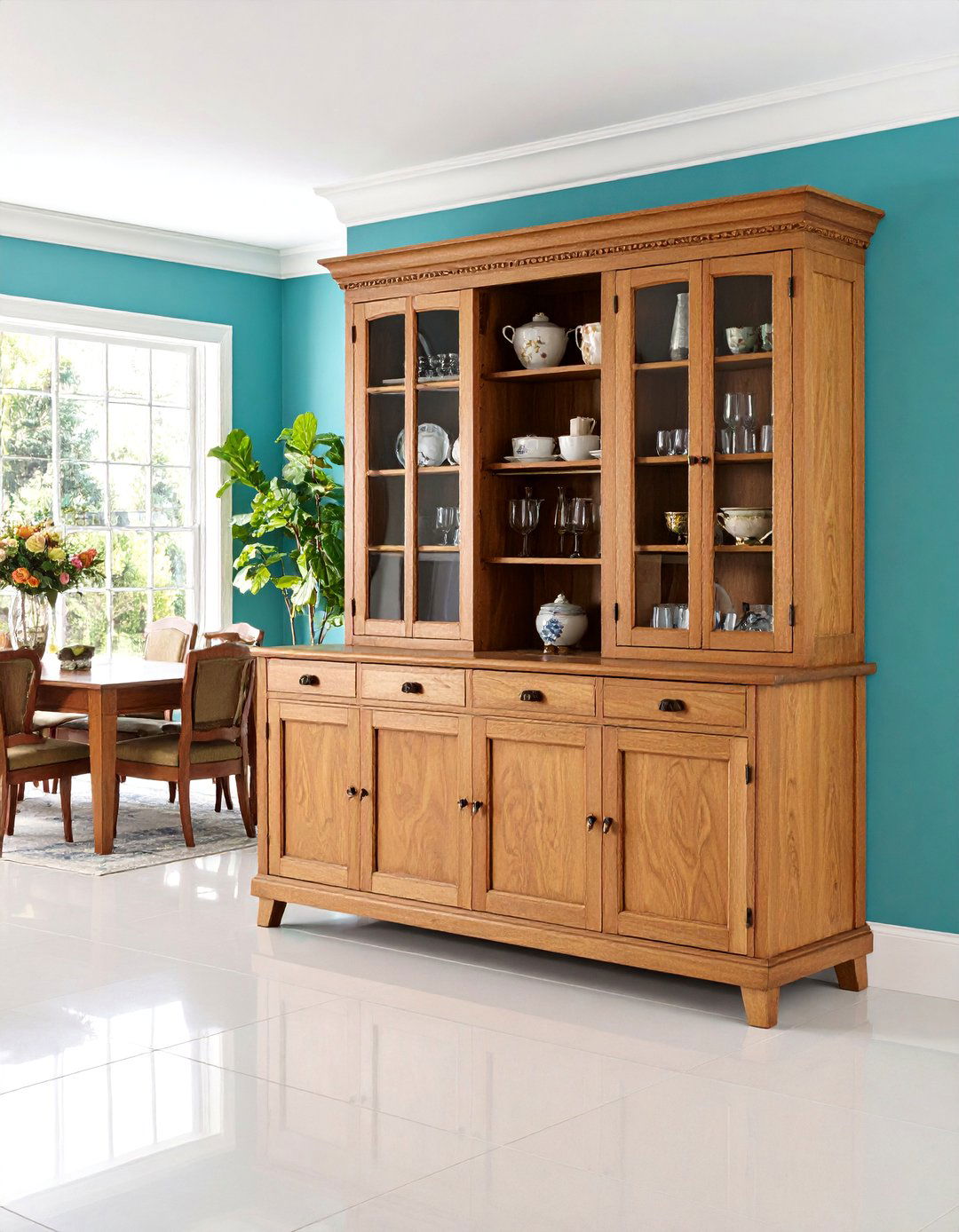
Integrate architectural storage into your colonial dining room with a custom built-in hutch that maximizes both function and period authenticity. Design the hutch with upper glass-front cabinets for displaying china and collectibles, and lower solid doors or drawers for concealed storage. Use traditional construction details like raised panels, crown molding, and period-appropriate hardware to match your room's colonial character. Paint the hutch in classic white or cream, or stain it to complement your dining furniture. The built-in appearance creates seamless integration with your room's architecture while providing essential storage for dining necessities. Position the hutch along a suitable wall where it can serve as both practical storage and decorative focal point that enhances your colonial dining room's organized, purposeful atmosphere.
13. Neutral Palette Colonial Dining Room Color Scheme
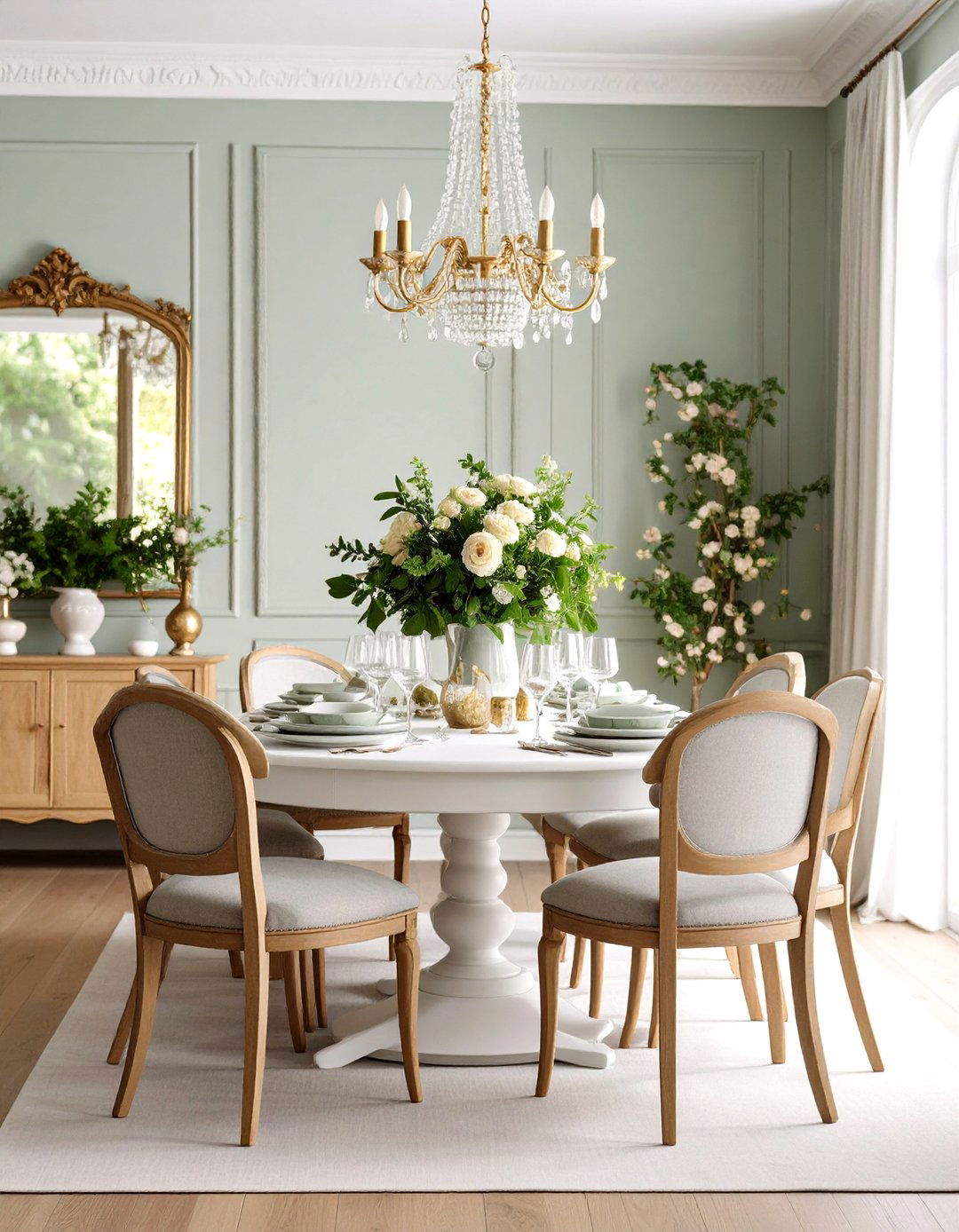
Create a harmonious colonial dining room using a carefully curated neutral color palette that reflects the era's natural dye traditions. Begin with warm white or cream as your base color for trim, wainscoting, and ceiling. Add depth with sage green, soft gray, or muted blue for wall colors above paneling or as full-wall treatments. Incorporate warm brown wood tones through furniture, flooring, and architectural details. These understated colors provide the perfect backdrop for colonial furniture and accessories while maintaining the serene, sophisticated atmosphere characteristic of the period. Avoid bold or bright colors that would conflict with the colonial aesthetic. Instead, let natural materials and traditional craftsmanship provide visual interest within this timeless, comfortable color scheme that enhances intimate dining experiences.
14. Mixed Wood Colonial Dining Room Furniture
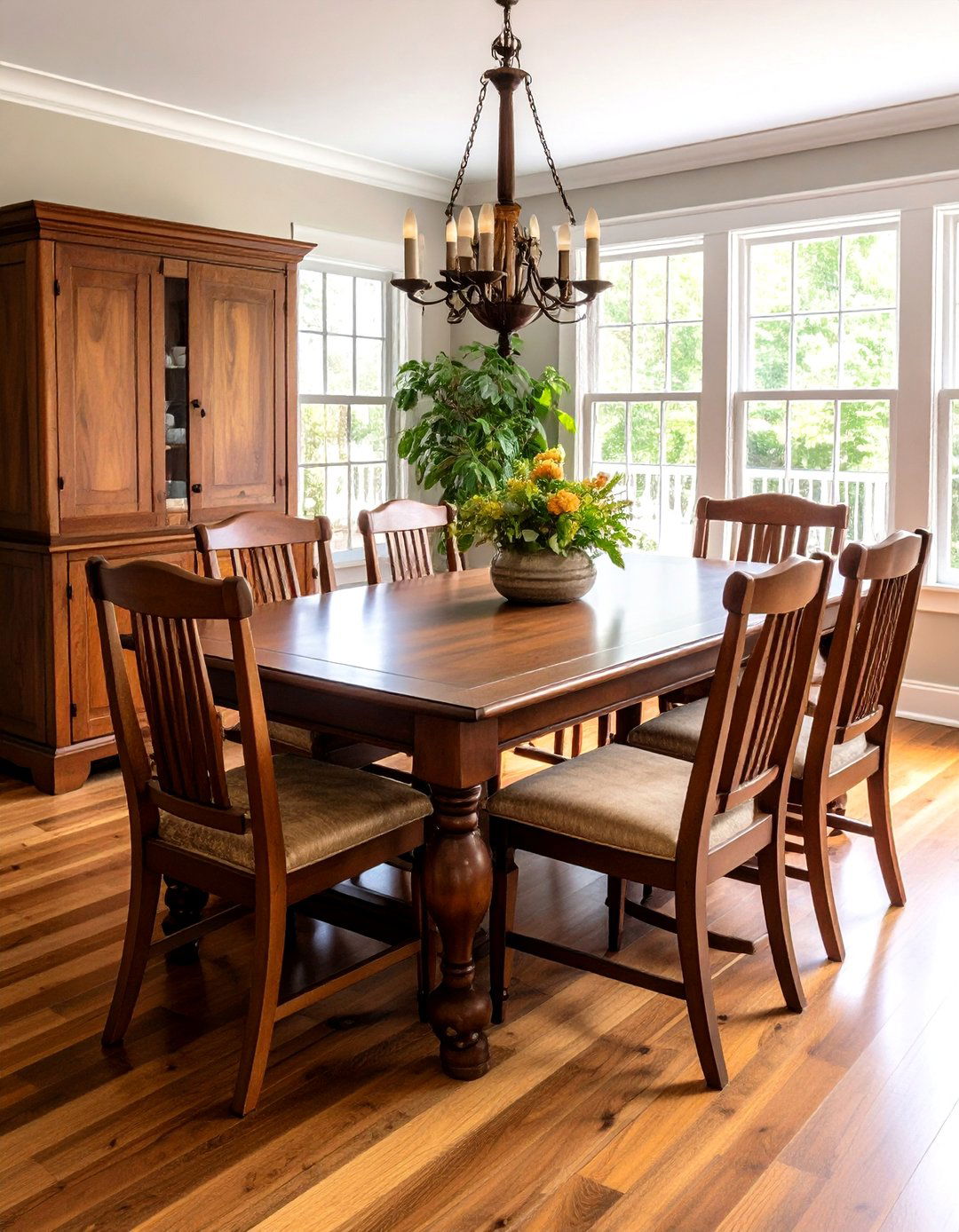
Embrace the authentic colonial approach by mixing different wood species throughout your dining room furniture selection. Combine a cherry dining table with maple Windsor chairs, or pair an oak hutch with pine wainscoting to create visual richness and historical accuracy. Colonial craftsmen used locally available woods, resulting in naturally varied furniture collections that developed character over time. This approach adds depth and interest while remaining true to period practices. Ensure harmony by selecting pieces with similar construction methods and proportions, even when using different wood species. The varied grain patterns and natural color variations create a collected-over-time appearance that captures the authentic colonial spirit where functionality and local materials determined design choices rather than strict matching requirements.
15. Exposed Beam Colonial Dining Room Architecture
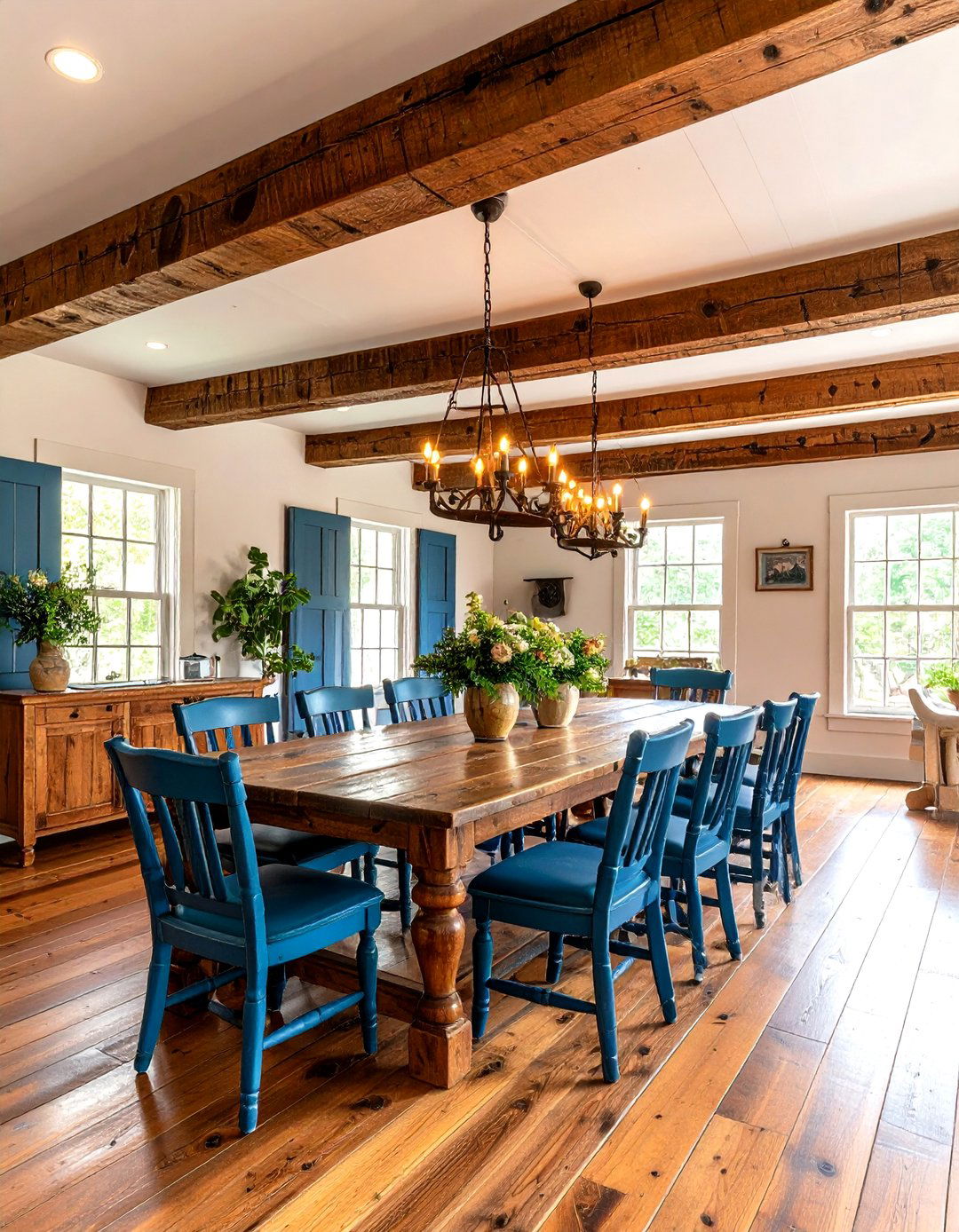
Highlight your colonial dining room's architectural heritage with exposed ceiling beams that add rustic charm and historical authenticity. Whether original to your home or added as decorative elements, wooden beams create visual interest and define the space's colonial character. Choose beams proportional to your room size, avoiding overwhelming smaller spaces with overly heavy elements. Natural wood finishes in oak, chestnut, or pine complement colonial furniture while adding texture to the ceiling plane. The horizontal lines of exposed beams balance vertical elements like tall hutches or paneled walls. Consider adding traditional details like mortise and tenon joinery or hand-hewn textures for enhanced authenticity. These architectural features embody the colonial emphasis on exposed structural elements and honest construction methods.
16. Antique Sideboard Colonial Dining Room Buffet
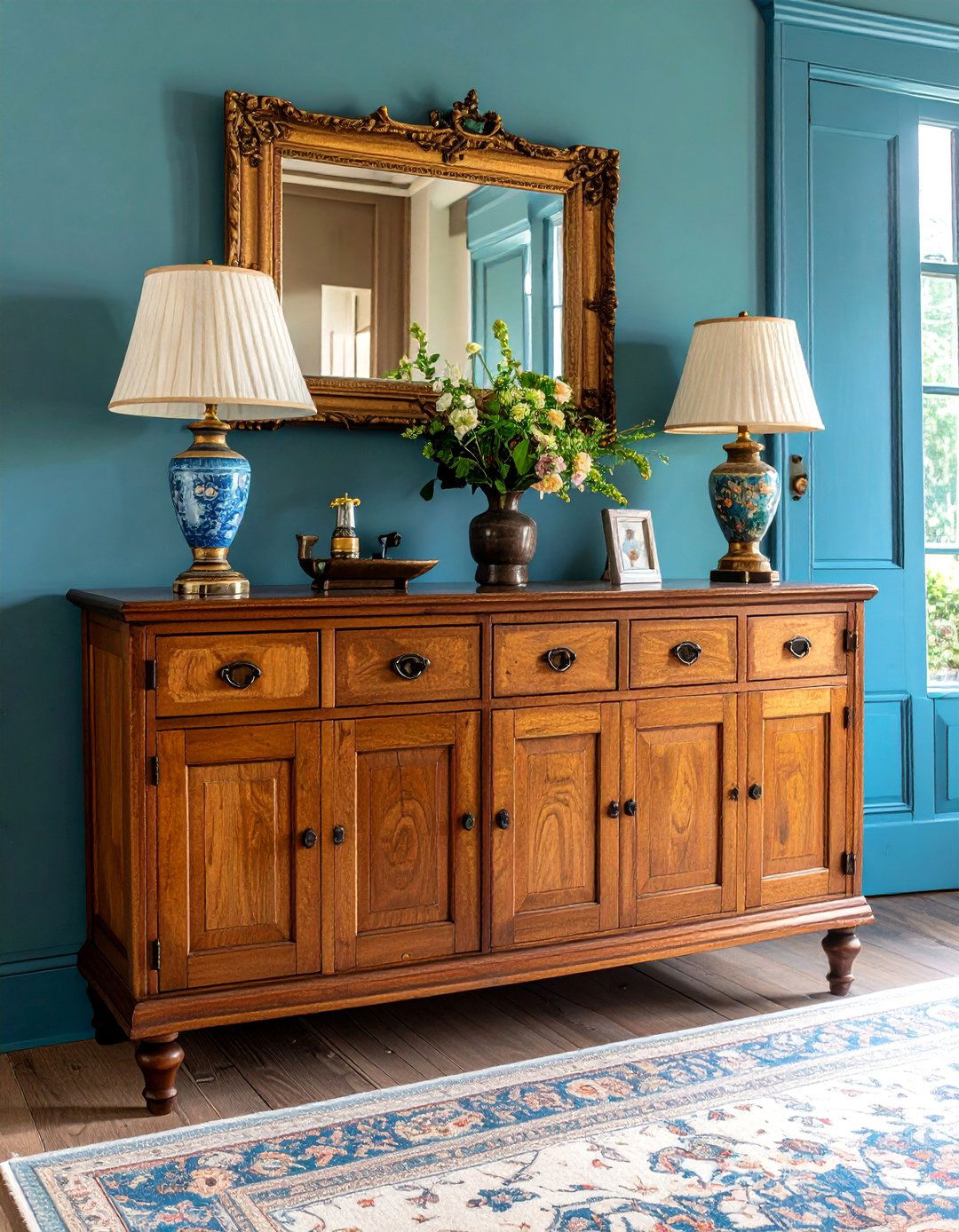
Incorporate an authentic antique sideboard into your colonial dining room to provide both practical storage and historical character. Choose pieces featuring traditional construction details like dovetail joints, hand-forged hardware, and solid wood construction typical of colonial-era furniture. The sideboard should complement your dining table while offering storage for linens, serving pieces, and seasonal decorations. Look for examples with classic proportions, simple lines, and minimal ornamentation that reflect colonial design principles. Position the sideboard against a suitable wall where it can serve as a serving station during meals and display surface for pewter, ceramics, or seasonal arrangements. These functional pieces embody the colonial emphasis on practical beauty and skilled craftsmanship while adding authentic period character to your dining space.
17. Botanical Print Colonial Dining Room Art

Decorate your colonial dining room walls with botanical prints that reflect the period's interest in natural history and scientific illustration. Choose reproduction prints of native American plants, herbs, or flowers that colonists would have encountered and cultivated. Frame the prints in simple wooden frames painted in period colors or left natural to complement your colonial décor. Arrange prints in symmetrical groupings above sideboards, between windows, or on walls not occupied by architectural elements like wainscoting. The detailed illustrations add educational interest while maintaining the colonial emphasis on natural subjects and practical knowledge. These artworks provide sophisticated decoration without overwhelming the space's authentic character, creating conversation pieces that enhance the intellectual atmosphere valued in colonial dining rooms dedicated to both nourishment and enlightenment.
18. Natural Textile Colonial Dining Room Linens
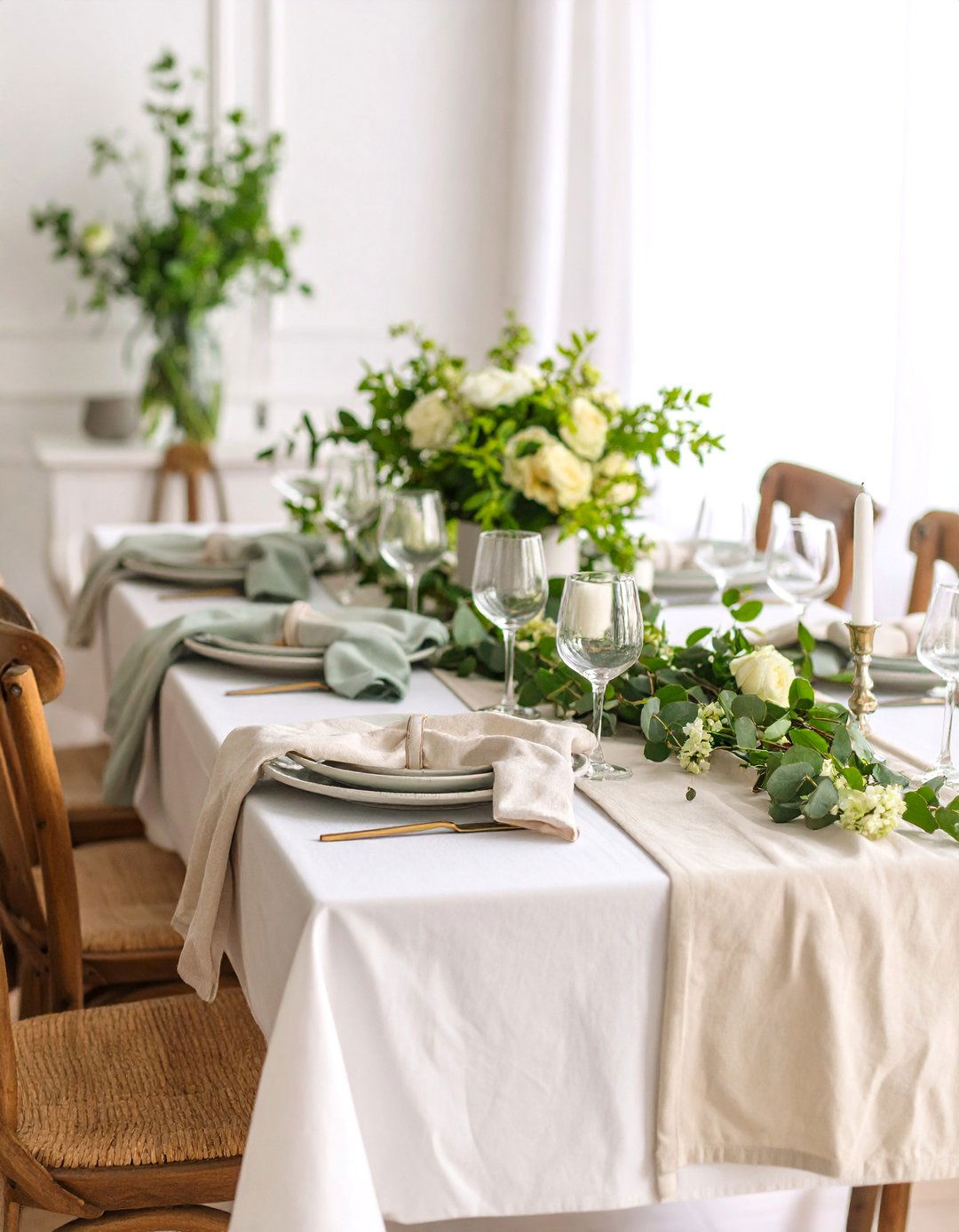
Complete your colonial dining room with natural textile linens that embrace traditional materials and understated elegance. Choose table runners, placemats, and napkins made from linen, cotton, or hemp in natural colors like cream, sage, or soft blue. These materials reflect colonial textile traditions while providing practical protection for your wooden dining table. Select patterns sparingly, favoring simple checks, stripes, or solid colors over elaborate designs that would conflict with the period aesthetic. Hand-hemmed edges and simple construction details add authenticity to your table settings. Natural textiles develop character through use and laundering, creating the lived-in appearance valued in colonial design. These practical elements enhance your dining experience while maintaining the honest, functional approach that defines authentic colonial interior design and hospitality traditions.
19. Rustic Chandelier Colonial Dining Room Statement
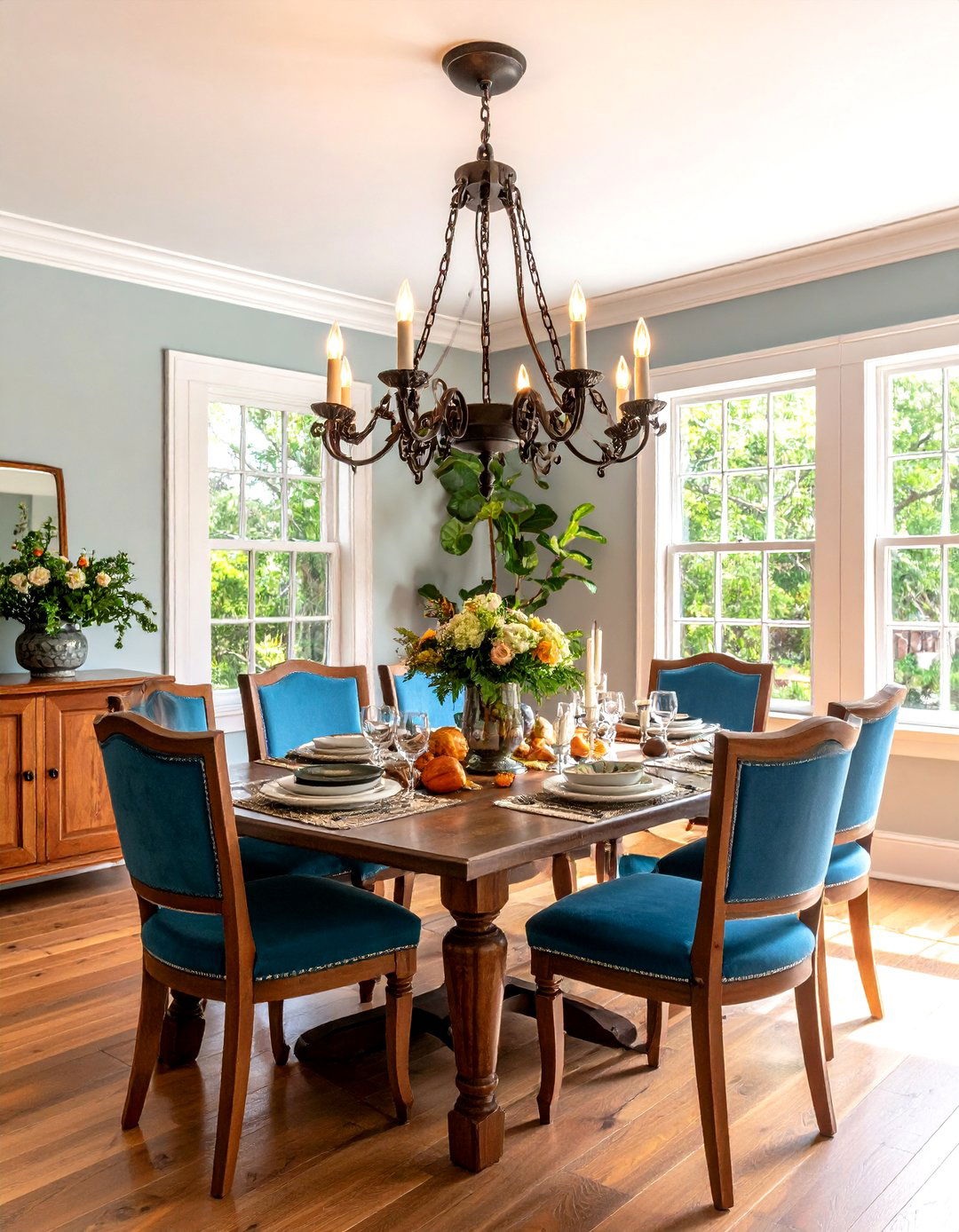
Create a striking focal point with a rustic chandelier that embodies colonial craftsmanship and natural materials. Choose fixtures featuring wrought iron, distressed wood, or combinations of metal and natural elements that reflect traditional colonial metalwork and woodworking skills. The chandelier should provide adequate lighting while making an architectural statement appropriate to your room's scale and character. Rustic finishes like aged bronze, blackened iron, or weathered wood complement the natural materials used throughout colonial interiors. Position the fixture to illuminate your dining table while creating ambient lighting throughout the space. This approach honors the colonial tradition of functional beauty, where lighting fixtures served essential purposes while showcasing local craftsmen's skills and creativity within the constraints of available materials and techniques.
20. Traditional Panel Colonial Dining Room Molding

Enhance your colonial dining room's architectural character with traditional panel molding that creates sophisticated wall treatments reminiscent of Georgian and Federal period design. Install rectangular or square panel frames using simple molding profiles that add depth without overwhelming the space. Paint panels and molding in coordinating colors, using darker shades within frames and lighter tones for raised elements to create visual interest. This technique works effectively on full walls or as wainscoting alternatives in rooms with higher ceilings. The geometric patterns provide structured elegance while maintaining colonial simplicity and proportion. Traditional panel molding demonstrates the period's appreciation for mathematical harmony and classical design principles, creating dignified backdrops for colonial furniture and accessories while adding lasting architectural value to your dining room.
Conclusion:
Colonial dining rooms offer timeless appeal through their emphasis on natural materials, traditional craftsmanship, and functional beauty. These twenty ideas demonstrate how authentic colonial elements like Windsor chairs, brass chandeliers, and wainscoting can create sophisticated spaces perfect for modern living. Whether incorporating individual elements or embracing comprehensive colonial design, these concepts help achieve the warm, welcoming atmosphere that makes colonial dining rooms enduringly popular for family gatherings and entertaining.


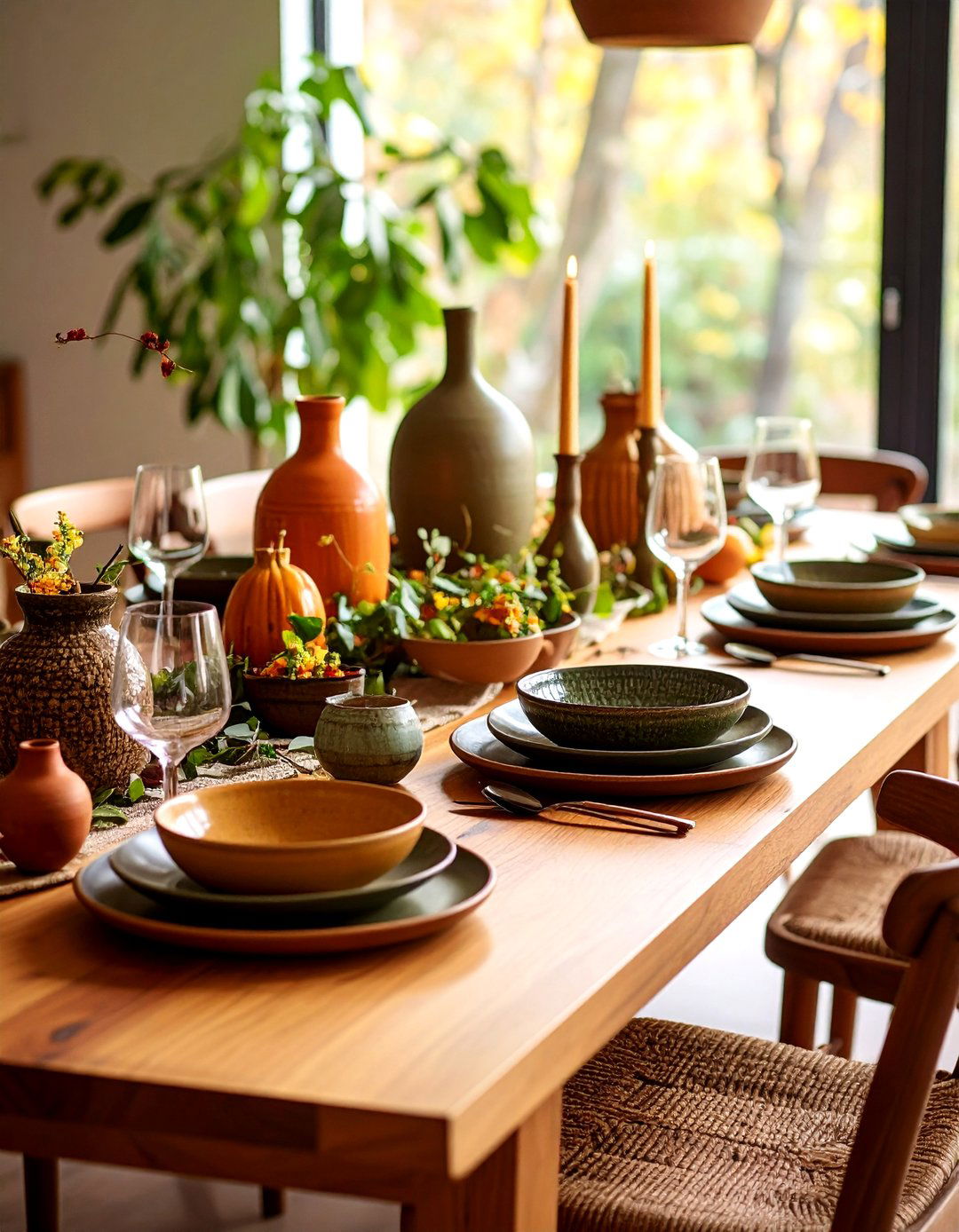

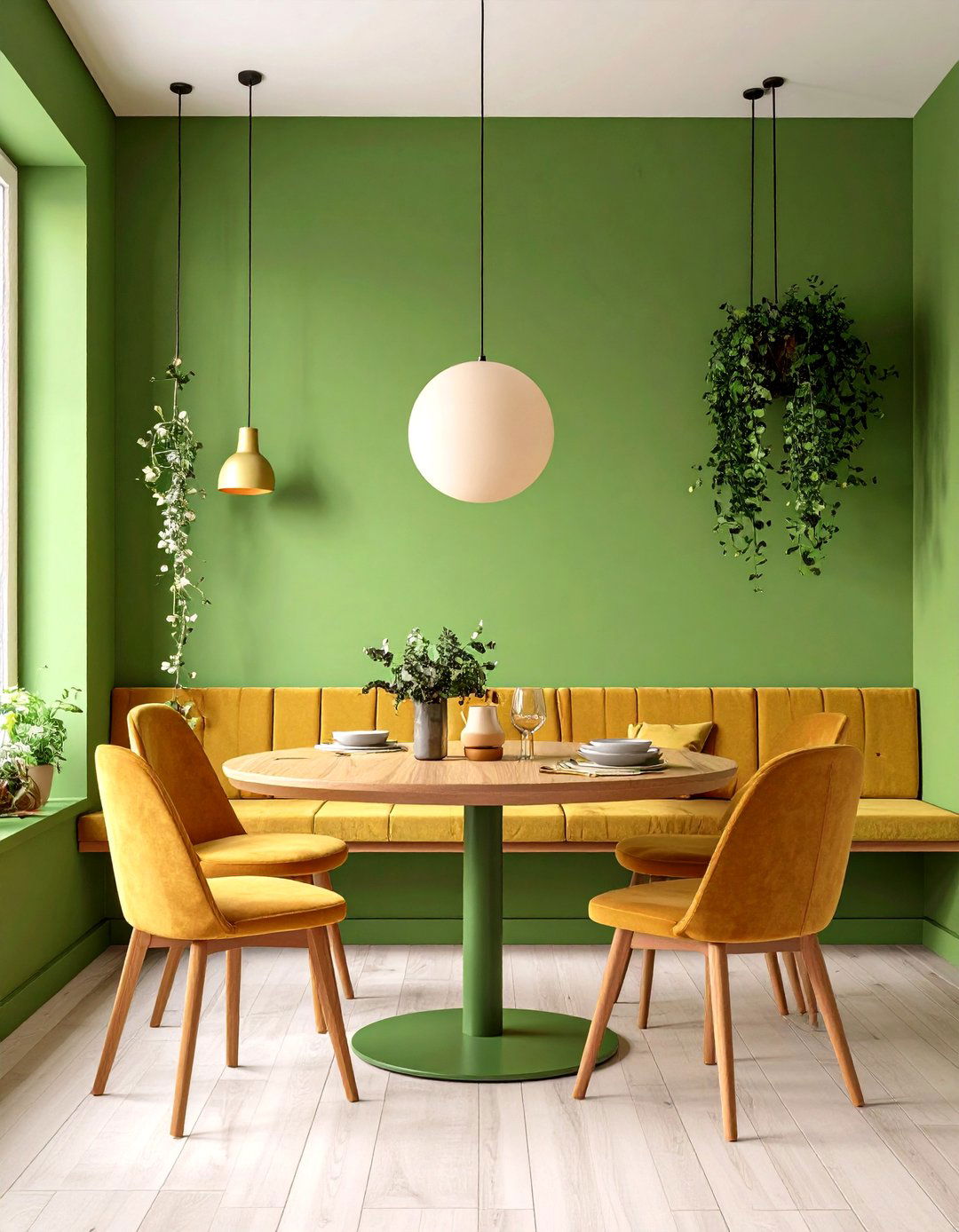

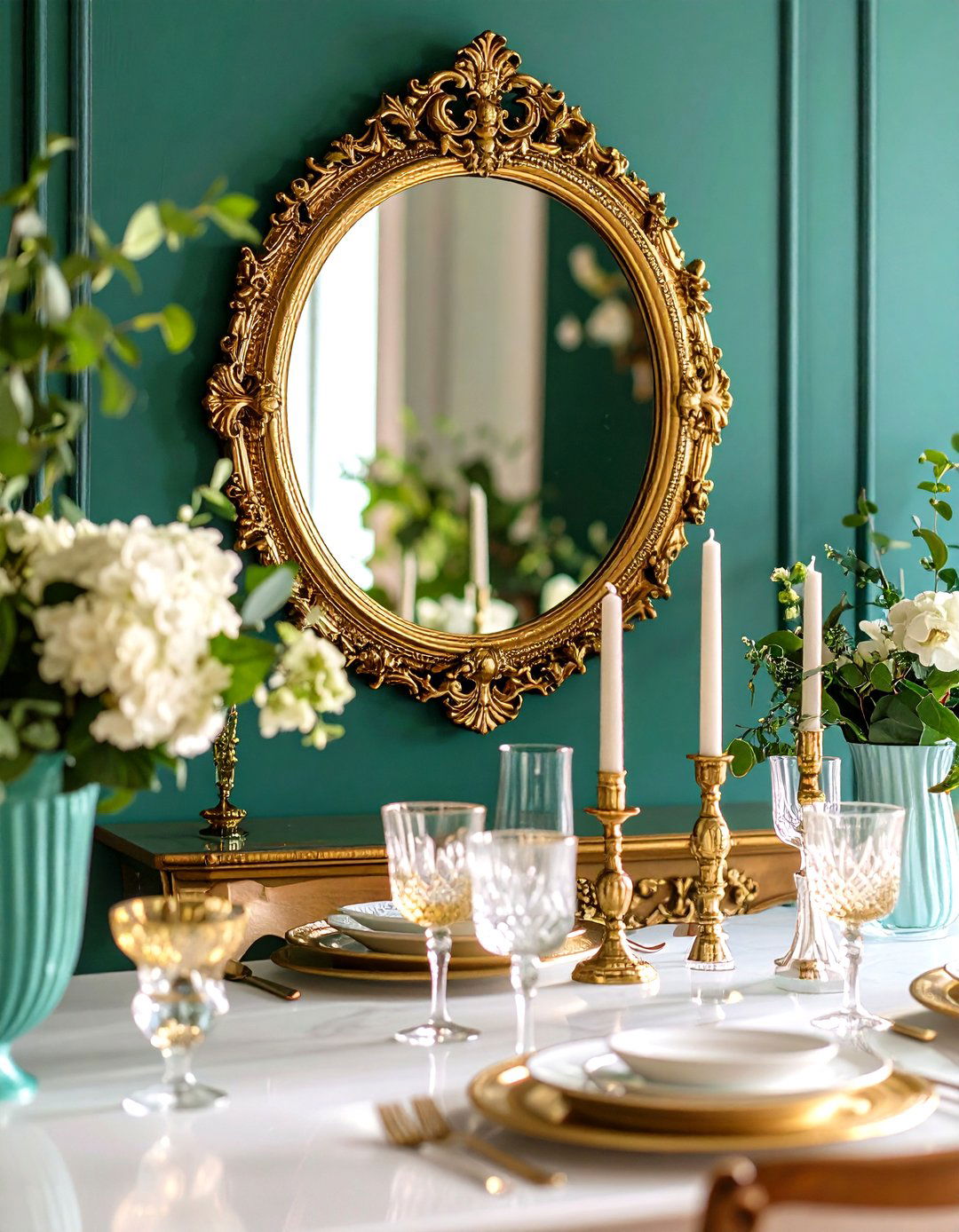
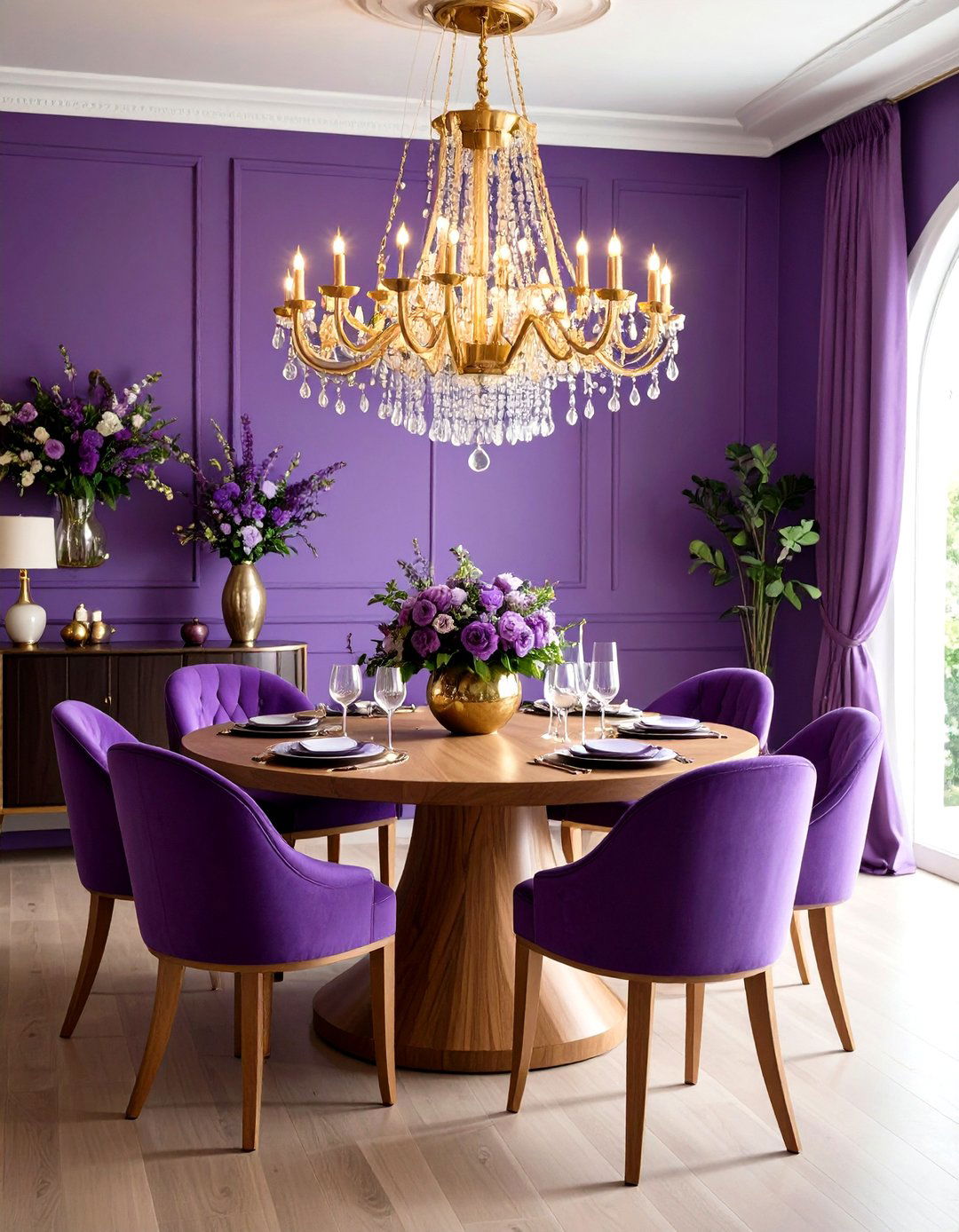
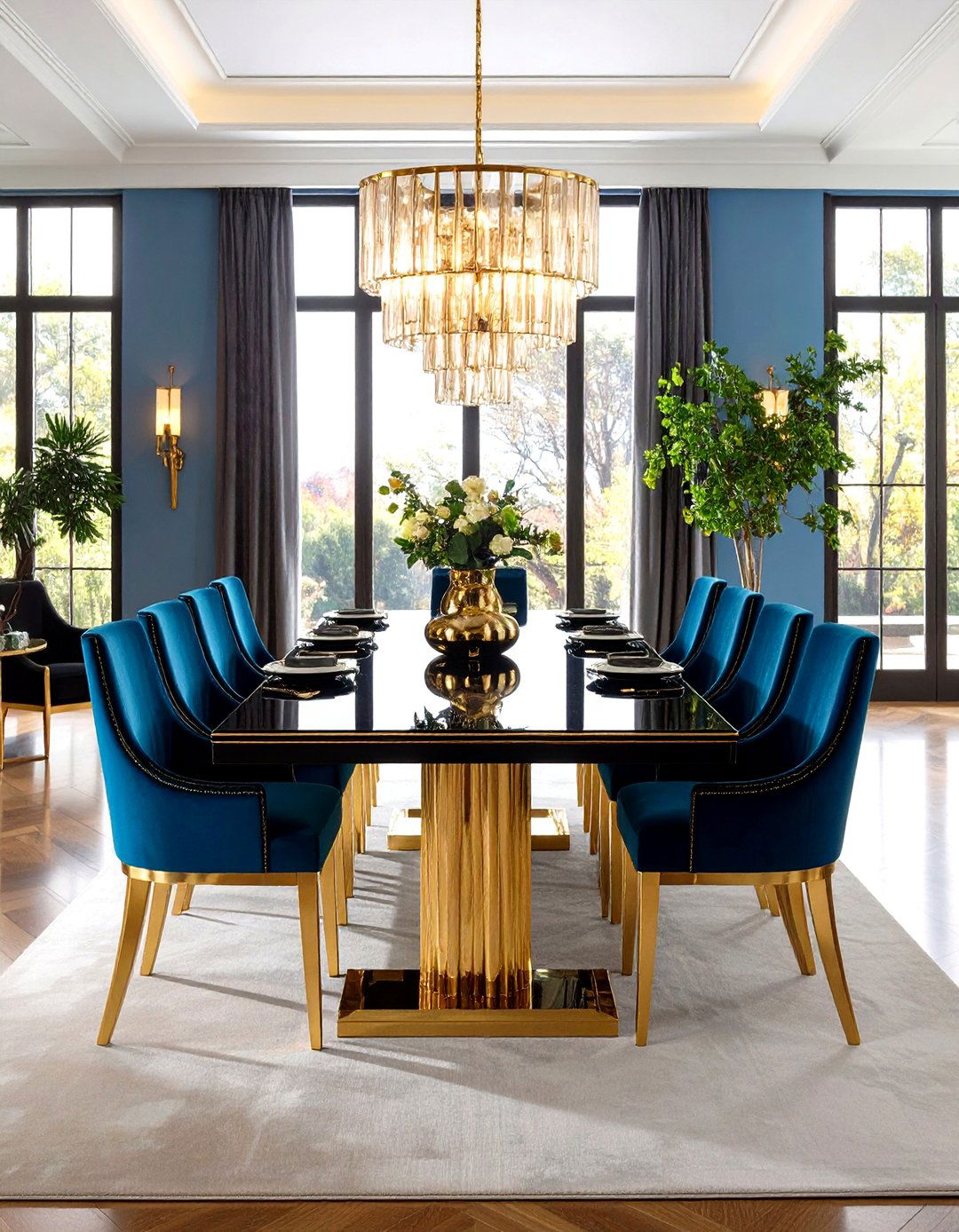
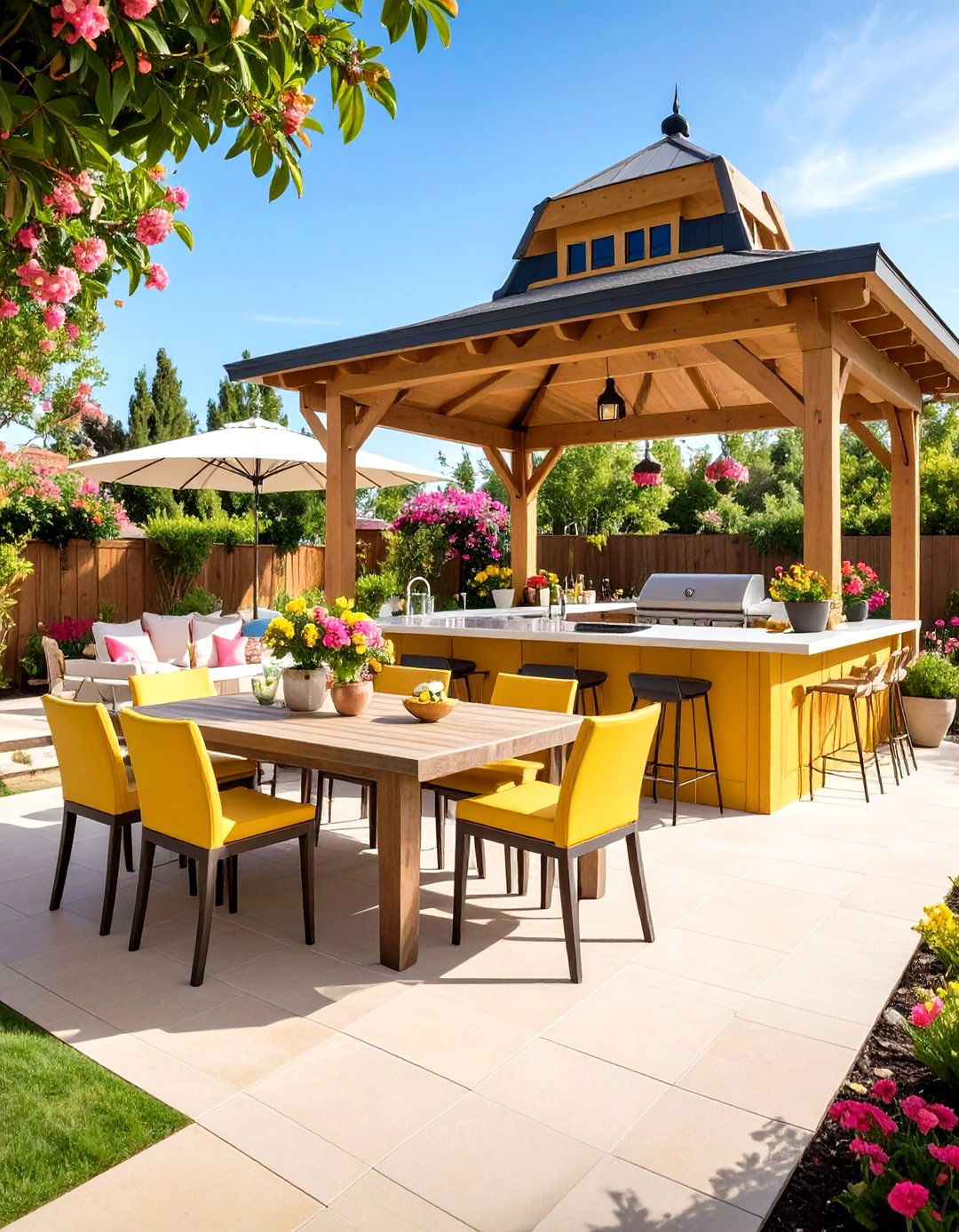
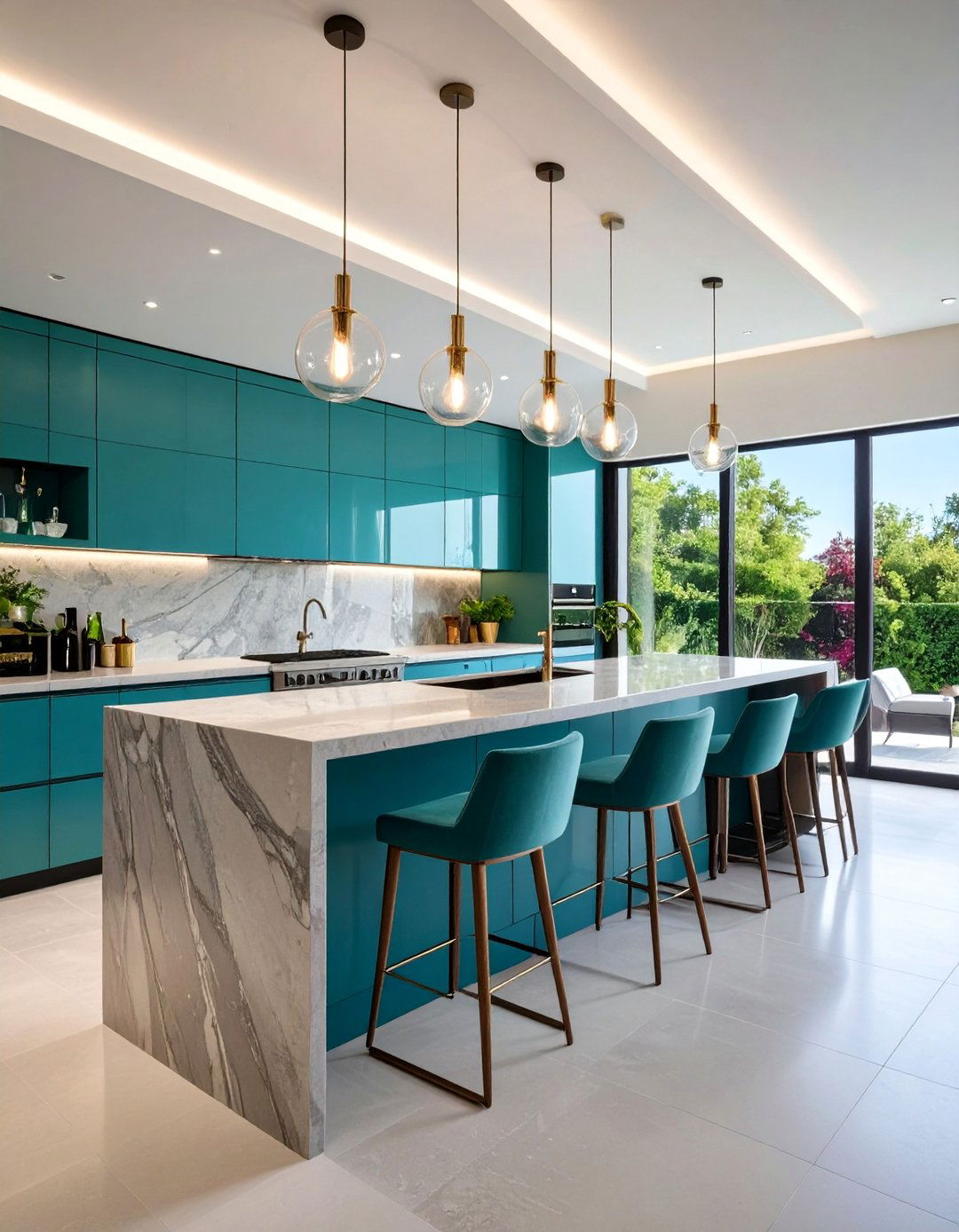
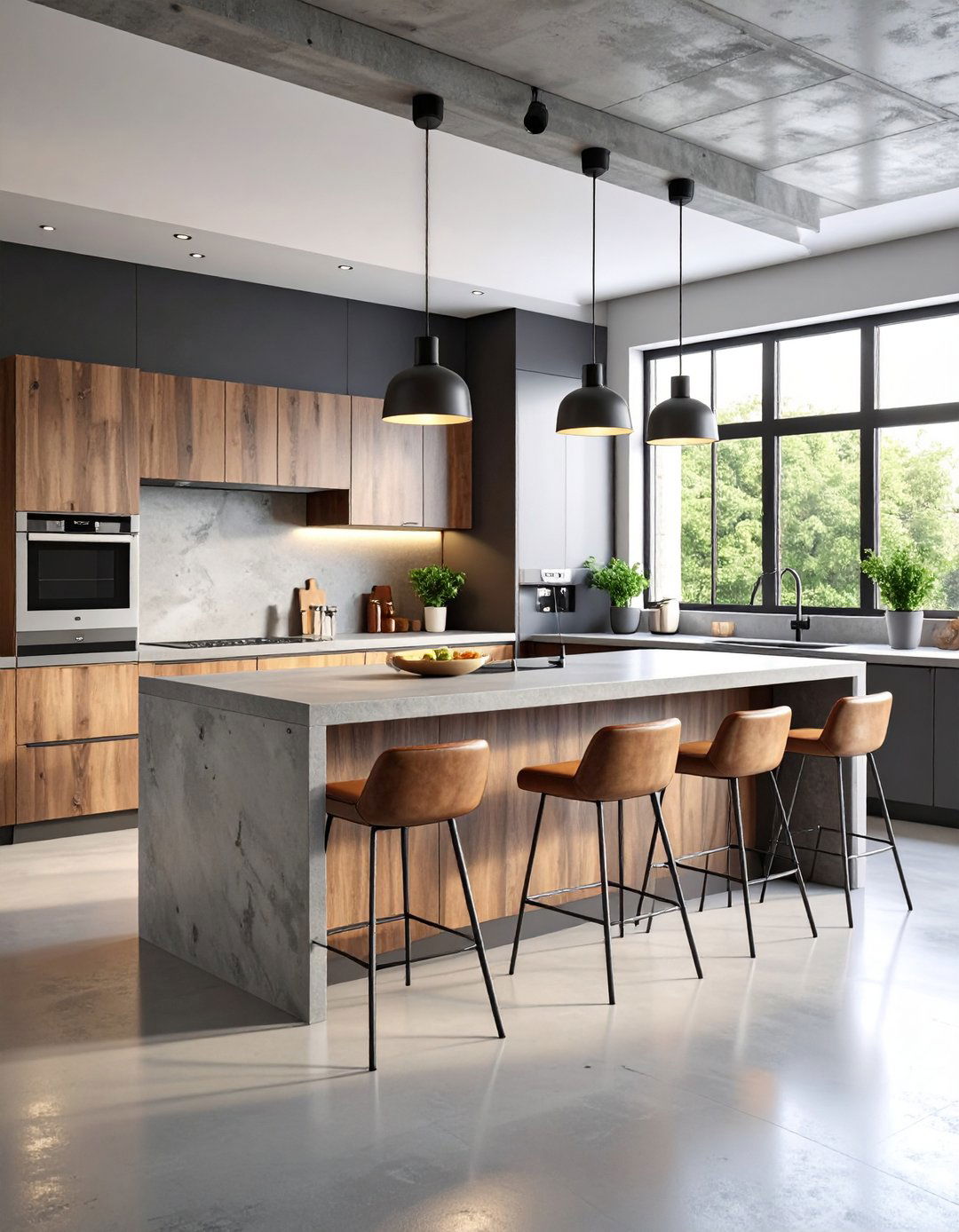

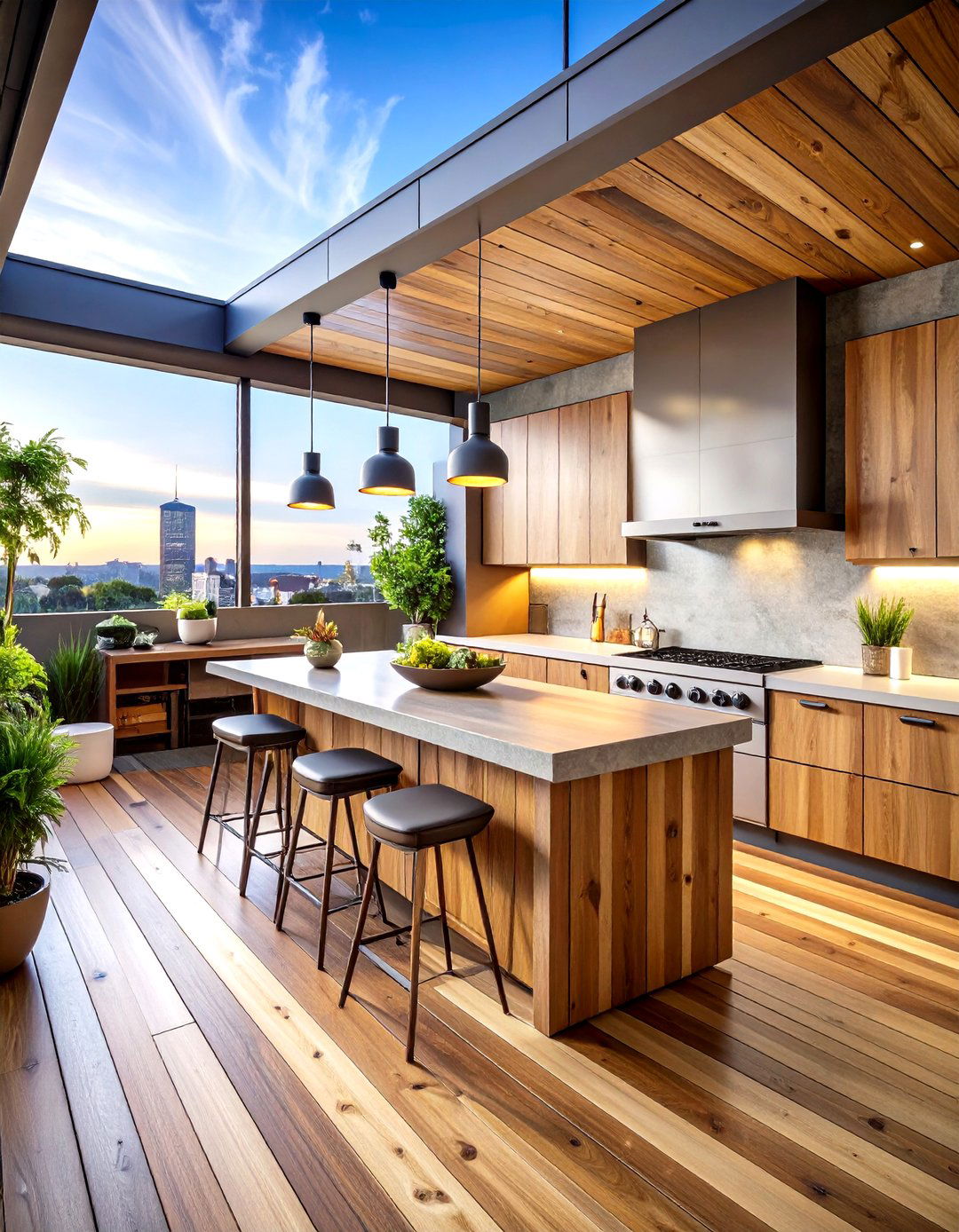
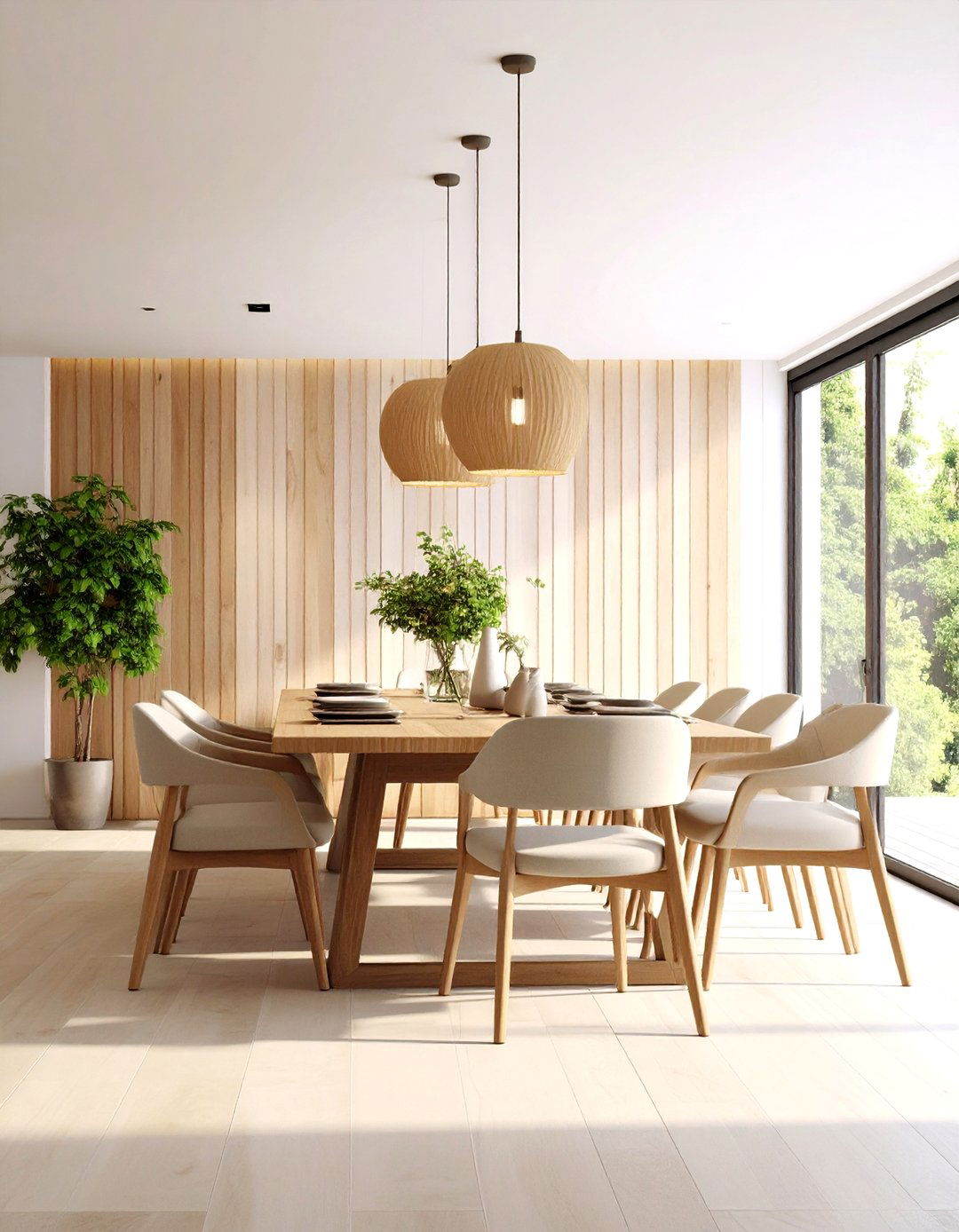
Leave a Reply